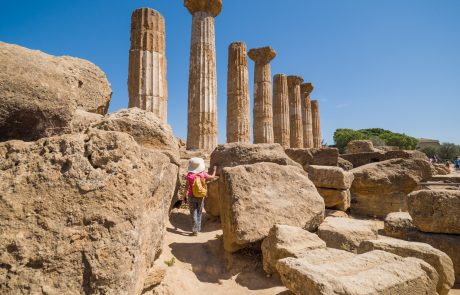LANDSCAPE AND ARCHAEOLOGICAL PARK OF THE VALLEY OF THE TEMPLES
Dettaglio
Have you ever dreamed about taking a walk back in time, among massive columns, perfectly preserved temples, flowering almond trees and ancient olive trees? It seems like a dream, but it is reality: we are talking about the Archaeological and Landscape Park of the Valley of the Temples. The Park preserves the monumental heritage of Akragas, one of the most important Greek colonies in the Mediterranean, and has been a Unesco World Heritage Site since 1997; in 2015 it received the DEUV (Declaration of Exceptional Universal Value).
Are you ready for an immersive journey into History and Beauty?
Let’s start from the Valley of the Temples, in Contrada San Nicola (Agrigento). Geloi settlers in 580 BC founded Akragas. The city soon became one of the most monumental in Greek Sicily. The massive Doric temples were built at the end of the sixth century BC. In the same ages, the temple of Hercules was erected, and the settlers also created a sacred wall. The temples look like a sacred embrace to the city. The philosopher Empedocles lived and worked here, shortly before the Carthaginian troops destroyed the city in 406 BC. But the centre continued to live, with new periods of prosperity, even under the Romans, who gave it the name of Agrigentum. What remains of the ancient splendour? There are eleven Doric temples, three sanctuaries, a necropolis, hydraulic works, fortifications, the agora, an Olympeion and a Bouleuterion. The Valley of the Temples is almost unique for the incredible (and miraculous) state of conservation of its monumental heritage.
Once you get to the ticket office, you will come across the Temple of Juno (the name, like that of other Agrigento monuments, is conventional; it is the result of misinterpretations of the past) dating back to around 460 BC and, in front of it, the remains of the sacrificial area. We walk along the Via Sacra towards the Temple of Concordia. This temple is one of the masterpieces of the Doric style. Together with the temples of Hera at Paestum and the Temple of Hephaistos or Teseion in Athens, it is one of the best-preserved sacred monuments of its time. A modern statue of Icarus stands in front of the temple, donated by the Polish sculptor Igor Mitoraj. Continue and, after passing the Villa Aurea, you will find the Temple of Heracles (or Hercules), the oldest of the Agrigento temples (6th century BC). Under the temple, a few hundred meters away, you can see a Roman sepulchral monument, improperly called the “tomb of Theron“. Through the Hardcastle entrance, you enter the area of the colossal Temple of Zeus or Olympian Jupiter, one of the largest in the Greek world, which in ancient times appeared with telamons (figures of men) 7.61m high. Today, in the temple centre, there is a cast of a telamon. The original is preserved in the Archaeological Museum. In the area below, is the Sanctuary of the Chthonic Divinities (Demeter and Persephone), actually known as the Temple of Castor and Pollux (or of the Dioscuri). From here, you will find to the north the garden of Kolymbetra, the ancient source of water supply created by Terone, soon adapted to fish farming and frequented by all sorts of fauna. Today it is a garden managed by the FAI where you can explore the enormous variety of flora that has settled here. Continuing south in the direction of Villaseta, you reach the Temple of Vulcano or Hephaestus, of which the basement and two columns remain.
Returning towards the Porta Aurea and going up towards the modern city, you will arrive at the hill of San Nicola where the upper agora once stood. After enjoying the magnificent view of the temples and the sea, you will find the Ekklesiasterion (the meeting place of the people’s assembly). Here, the Regional Archaeological Museum was built on the remains of the Cistercian monastery. Do not miss the vascular collection, the telamon and the famous Ephebe of Agrigento. Isn’t it amazing? And that’s not all.
The Valley of the Temples Archaeological Park also provides new features and unmissable experiences. A few steps from the Temple of Concordia, you’ll find “Casa Barbadoro Diodoros” a true temple of taste! Inside the ancient farmhouse, you can delight yourself with special gourmet tastings of products grown right in the Park, accompanied by interesting narrations by local experts. Another interesting experience is a visit to the Sensory Garden, a slice of heaven a few steps from the Temple of Concordia.
Yes, because the Park also includes other sites in the Agrigento area, which tell the stories of different eras. Like the archaeological area of Sant’Angelo Muxaro, in the homonymous municipality. It is the site of the mythical Camico, the fortified city built by the famous architect Daedalus (yes, the builder of the Minotaur labyrinth) who, fleeing from the Cretan king Minos here received hospitality from the Sican king Kokalos. On the southern slope of the hill, there is a Necropolis with cave-like tombs dating back from the 13th to the 6th century BC.
Or, again, the archaeological area of Eraclea Minoa, in Cattolica Eraclea. The area stretches out on a white headland towards the stunning seascape. Notable here is the Theatre.
Located on one of the beaches of the Costa del Mito, a short distance from the Scala dei Turchi, you will also find the Roman Villa of Realmonte overlooking the sea, with its spa sector covered in marble and mosaic floor. Towards the interior is the archaeological area of Monte Adranone (Sambuca di Sicilia), identified with the Adranon that Diodorus (XXIII, 4,2) mentions about the events of the first Punic war. And still, near the coast, you will find the Eneolithic Necropolis (IV-III millennium BC) of Contrada Tranchina in Sciacca, and the archaeological area of Monte Sant’Angelo in Licata, an outstanding settlement of the Hellenistic age.
Share this content!
LOCATION
DURATION
Distance
Difficulty
Places
AROUND






